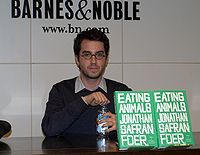Eating Animals
 Jonathan Safran Foer at Barnes & Noble Union Square to discuss his book Eating Animals. | |
| Author | Jonathan Safran Foer |
|---|---|
| Language | English |
| Genre | Non-Fiction |
| Publisher | Little, Brown and Company |
Publication date | 2009 |
| Publication place | United States |
| Pages | 352 pp (hardcover) |
| ISBN | ISBN 0316069906 Parameter error in {{ISBNT}}: invalid character |
| LC Class | TX392 .F58 2009 |
Eating Animals is the third book by the American writer Jonathan Safran Foer, published in 2009. It is a work of non-fiction.
Background
Jonathan Safran Foer spent much of his teenage and college years choosing between the omnivore and vegetarian lifestyles. When he discovered that he was to be a father, pondering the responsibility of making dietary choices on his son's behalf, he began to urgently explore his eating choices. His journey led to visits to factory farms in the middle of the night, ponderings on favorite meals from his childhood, and the questioning of some of the most elemental questions regarding the morality of eating animals. Combining philosophy, literature, science, memoir and his own detective work, Eating Animals examines the many fictions that Americans use to justify their eating habits, which ignore the very brutal conditions faced by factory farmed animals in United States.
Foer explores the horrors of factory farms and commercial fisheries, examining by-catch (Indonesian shrimp trawlers kill 26 pounds of sea creatures for every 1 pound of shrimp), slaughterhouse conditions (in American slaughterhouses, live cows are frequently bled, dismembered, and skinned), and the health risks that pervade factory farming (H1N1 originated in a North Carolina factory farm, and according to Consumer Reports, 83 percent of american chicken is infected with campylobacter or salmonella at the time of purchase).
Foer also examines the cultural meaning of food in family life, building on and ultimately criticizing the work of Michael Pollan. Finally, Foer examines humane agricultural methods, and the divide between animal rights and animal welfare, taking a conciliatory but principled approach.
Themes
Foer explores the horrors of factory farms and commercial fisheries. He examining topics such as by-catch and slaughterhouse conditions, learning that Indonesian shrimp trawlers kill 26 pounds of sea creatures for every 1 pound of shrimp, (Eating Animals 49), and that in American slaughterhouses, live cows are frequently “bled, dismembered, and skinned while conscious,” (Eating Animals 230). He also explores the health risks which pervade American factory farming, for example that H1N1 originated in a North Carolina factory farm, and that according to Consumer Reports, 83 percent of American chicken is infected with campylobacteria or salmonella at the time of purchase. (Eating Animals 139). Foer also examines the cultural meaning of food, beginning with the experience of his own grandmother, who survived the holocaust with a lifelong obsession over food. He builds on and ultimately criticizes the work of Michael Pollan on our relationship to the food we eat. Finally, Foer examines humane agricultural methods, and the divide between animal rights and animal welfare, taking a conciliatory but principled approach.
Style
Foer’s style varies from straightforward investigative reporting, to a very personal, memoir approach. He also includes post-modern touches such as graphic art, and interspersed essays from major figures in the book, which allows many voices to be heard directly.
Critical Reception
Eating Animals received mixed reviews. Some reviewers, such as New York Magazine and The Washington Post, were put off by Foer’s “safe conclusions,” and “sometimes-sanctimonious attitude” and “over-the-top writing,” while ultimately supporting him for revealing a “truth so powerful in this case that it doesn’t matter what your angle is.” While the NY Times Book Review was ambivalent about the efficacy of Foer’s arguments, the LA Times and The New Yorker reviewed Eating Animals favorably, lauding both the conclusions Foer reaches, and how he reaches them. In an article for the Huffington Post, Natalie Portman claims that “Jonathan Safran Foer's book Eating Animals changed me from a twenty-year vegetarian to a vegan activist.”
